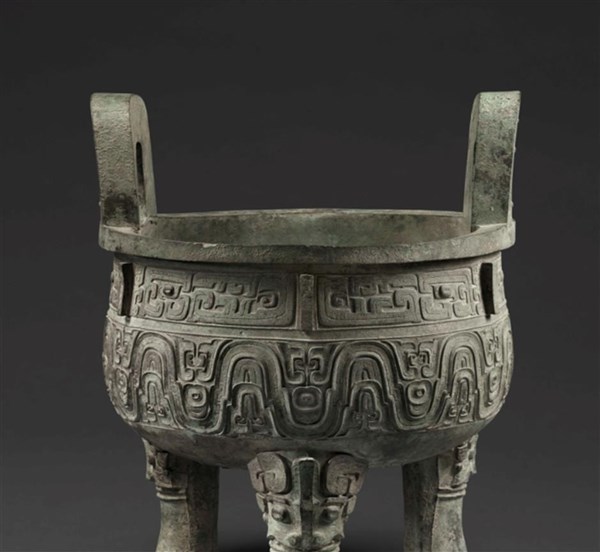今日上海
上海博物馆馆藏珍品大克鼎 - 2018年08月24日
The treasure of the Da Ke Ding

The gigantic Da Ke Ding, an almost 3,000-year-old bronze tripod, is one of the centerpieces of the Shanghai Museum.
The national treasure is displayed in the bronze gallery on the first floor.
Ding cauldrons, the round ones on three legs and the rectangular ones on four, have two facing handles and were used in ancestral rituals.
Ding symbolized authority, power and status, especially from the Xia Dynasty (c. 2070-1600 BC) to the Warring States Period (476-221 BC).
In the Zhou Dynasty (1046-256 BC), there was a strict rule governing the number of ding that a person was authorized to own.
Emperors had a privilege to own nine ding whilst feudal lords were allowed to have seven, ministers five and scholars three.
The owner of Da Ke Ding was Ke who was a “Shan Fu,” literally chef, in charge of the meals of King Xiao of Zhou.
So the bronze tripod is also called Shan Fu Ke Ding. However, Ke was much more than a chef: He also served as a high-ranking official highly regarded by the king.
Ke was in charge of sacrificial ceremonies, etiquette, and publicizing the king’s orders.
Seven smaller bronze cauldrons, a set of bianzhong consisting of six bronze bells, two xu — bronze food containers — and a bo — a bronze percussion instrument — all owned by Ke were unearthed together in Rencun Village, Fufeng County in Shaanxi Province in the late Qing Dynasty (1644-1911).
Both the rim and the legs of the Da Ke Ding were cast with taotie motifs, which is commonly found on Chinese ritual bronze vessels from the Shang (1600-1046 BC) and the Zhou dynasties. Taotie, described as one of the “four evil creatures of the world” in the “Classic of Mountains and Seas,” is a mythological figure in Chinese legend, representing greed.
Many experts believe that the ferocious look of the taotie motif created a sense of mystique and stateliness, which made the public stand in awe of the owners and their dominance.
The body of the bronze tripod was engraved with wave patterns and the handles with dragons.
Inside the tripod, 290 Chinese characters are inscribed in two paragraphs and 28 lines. The inscription documents the achievements of Ke’s grandfather and the admiration for his noble virtues in the first paragraph, and the rewards, including lands, slaves and clothes, granted by the king in the second paragraph.
The inscription not only offers important evidence of the land grant system, the practices and official positions of the Western Zhou period (1046-771 BC)but also had a great impact on the calligraphy and seal cutting.
Da Ke Ding is known as one of the “Three Treasures within Four Seas” along with Da Yu Ding and Mao Gong Ding, which are exhibited in the National Museum of China in Beijing and the Palace Museum in Taipei.
All the three bronze tripods were excavated in the late Qing Dynasty.
Both Da Ke Ding and Da Yu Ding were collected by the same man, Pan Zuyin (1830-90), a politician, scholar and dedicated collector of antiques especially ritual bronzes.
Da Yu Ding was sent by Zuo Zongtang (1812-85), a Chinese statesman and military leader of the late Qing Dynasty, to Pan as a gift.
Spending a large sum of money, Pan purchased Da Ke Ding from Ke Shaotai from Tianjin.
His collection was kept safe in his hometown Suzhou in Jiangsu Province.
After the death of Pan Zuyin, his brother Pan Zunian inherited the collection.
Pan Dayu (1906-2007) married into the Pan family at the age of 18. Tragically, her husband died only three months after their marriage. Before he died, he reminded Pan that she must protect the bronze tripods.
With the outbreak of the war of resistance against Japanese invasion in the 1930s, Pan asked two carpenters to make several wooden boxes which were used to store the family’s treasures. The boxes containing the Da Ke Ding and the Da Yu Ding were buried.
During the war, Japanese robbers pillaged her house seven times but still couldn’t find the treasures.
The wooden cases rotted away seven years later. Unearthing the two bronze tripods, Pan hid them in a room until the end of the Chinese civil war.
In July 1951, Pan wrote a letter donating the two cauldrons to the Shanghai Municipal Commission of Administration of Cultural Relics.
In return, the commission awarded her cash, which was refused by Pan, and a citation, which hung on her bedroom wall for 50 years.
In 1952, the two national treasures were exhibited in the Shanghai Museum. In 1959, Da Yu Ding was moved to Beijing. To celebrate the centenary of Pan’s birth, a special exhibition displaying the Da Ke Ding and the Da Yu Ding together was held in 2004.
Looking at her two old “family members” carefully, Pan said: “Very good, nothing changes. I have found a nice family for them.” Pan passed away in Suzhou in 2007. Her legacy and spirit live on and her name is on the wall of the Shanghai Museum.
